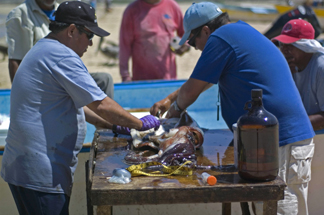Ted Uyeno has been filled with curiosity for how things work since he was a child. At five years old while visiting a tide pool on Vancouver Island, he touched a sea anemone for the first time and wanted to know how it worked. That simple act set Uyeno on a path of scientific research and discovery—a path that eventually led him to Northern Arizona University.
A postdoctoral research associate and adjunct professor in the biology department at NAU, Uyeno’s curiosity is currently rapt in the study of circulatory systems of cephalopods, mainly squid. He is intent on discovering how its evolved systems may lead to new treatments for human ailments.
Referring to himself as a “reverse mechanic,” Uyeno examines the structure of an existing biological system and deconstructs it to understand how it functions. He then takes that understanding and relates it to other species.
“It’s called comparative biomechanics,” Uyeno says. “We look at homologous structures of species and compare them to determine why differences occur.”
|
Uyeno believes squid can teach us how to treat peripheral arterial disease, which can be caused by diabetes and atherosclerosis. The possible applications of a squid’s circulatory system struck him one day when his friend asked him for a ride.
“He needed a lift because his diabetes had led to having one of his feet amputated,” Uyeno says. “Diabetes leads to amputation when blood vessels lose elasticity, and blood begins pooling in the extremities. There’s not enough pressure to get the blood back to the heart.”
Uyeno thought of the evolutionary twists and turns which led to squid and other cephalopods shedding the slow, slimy trail of their ancestors and developing advanced, efficient systems that cinched them higher up on the food chain.
As squid evolved from their distant snail-like relatives, their circulatory system changed from an open, low-pressure system to a closed system that supports a more vigorous level of activity. Their circulatory system includes a central, larger heart which pumps blood to the tissues while two smaller accessory hearts force blood through the gills and back to the central heart.
High-energy animals driven by jet propulsion, squid can out-swim tuna over short distances. Their unique circulatory system and accessory hearts boost efficiency. Uyeno admits that relating circulatory systems of squid to a possible solution for peripheral arterial disease in humans could seem a stretch. But he sees potential answers in the evolution of squid, which has made them strong, large, fast and plentiful.
After studying Humboldt squid for three summers in the Sea of Cortez, Uyeno, his colleague Kiisa Nishikawa, and undergraduate student Duane Barbano have found practical applications in addressing peripheral arterial disease. Through NAU Ventures and a partnership with the Northern Arizona Center for Emerging Technologies, Uyeno hopes his research will make a difference in the lives of many people.
“A design for a biomedical device has been developed based on cephalopod circulatory morphology and the intellectual property is now being managed by NAU Ventures,” he says.
In the meantime, Uyeno’s research continues with squid, specifically examining how muscle articulation and flexibility can serve as biological inspiration for robotics devices. His curiosity surrounding marine creatures shows no sign of waning.
“Still, some 30-odd years later, I’m asking the same question: How do these work?”



